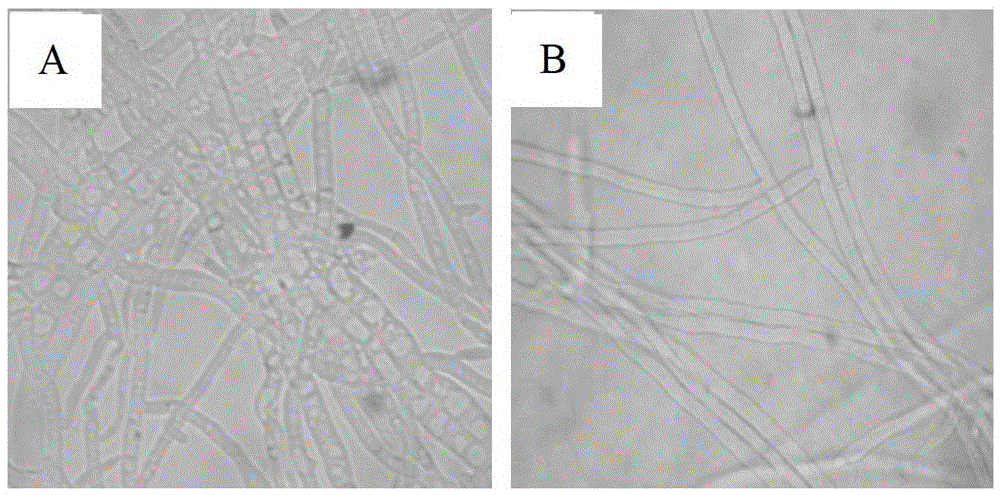Method for Separating and Purifying Antimicrobial Peptides from Plant Endophytic Bacteria Strains by High Performance Liquid Chromatography
A technology of high-performance liquid chromatography and plant endophytic bacteria, which is applied in the fields of peptide preparation methods, botany equipment and methods, and microbial-based methods, and can solve problems such as high cost, suicide of host microorganisms, and inability to obtain expression products
- Summary
- Abstract
- Description
- Claims
- Application Information
AI Technical Summary
Problems solved by technology
Method used
Image
Examples
Embodiment 1
[0028] The preparation of embodiment 1 bacterial strain B-011 of the present invention
[0029] Rinse the healthy tobacco plant samples collected from the tobacco bacterial wilt disease area in Changsha City, Hunan Province with sterile water, then dry the water with sterilized filter paper, then wash with 70% alcohol, and put the samples on the alcohol lamp to sterilize the surface. Bacteria, cut off the epidermis of the plant stem with a sterile knife, cut a small amount of xylem and put it into a test tube filled with 10ml sterile water. -1 -10 -4 , take 1ml bacterial solution for each gradient and apply it on the BPA plate medium, apply 1 plate for each concentration, repeat 3 times, and culture in a 28-30°C incubator. After culturing for 3 days, pick colonies of different shapes and re-streak on the plate for purification to obtain the strain of the present invention. Finally, transfer it to the inclined plane of the test tube and save it for later use.
Embodiment 2
[0030] Embodiment 2 Preparation of bacterial strain B-011 bacterium fermentation filtrate of the present invention
[0031] Preparation of seed solution: Inoculate the strain of the present invention preserved on a slant into BPY culture solution with a volume of 100mL / 250mL, initial pH 7.0, 30°C, 180r / min shaking culture for 24h.
[0032] Fermentation culture: Inoculate the seed liquid into BPY medium with 1% inoculum amount, the liquid volume is 100mL / 250mL, the initial pH is 7.0, 30°C, 180r / min shaking fermentation culture for 48h.
[0033] Fermentation broth treatment: centrifuge the liquid culture obtained through the above fermentation at room temperature at 10,000 r / min for 10 minutes, and filter the supernatant through a microporous membrane with a pore size of 0.22 μm to obtain a fermentation filtrate containing antibacterial active substances.
[0034] BPY culture medium / medium: peptone 10g, beef extract 5g, yeast extract 5g, NaCl 5g, glucose 5g, water 1000mL, pH7.0....
Embodiment 3
[0035] Embodiment 3 The influence of fermented filtrate of the present invention on tomato early blight spore germination
[0036] Cultivate tomato early blight bacteria on PDA for a certain period of time to produce spores, wash off the spores with a small amount of sterile water, add sterile water to dilute to 40 times objective lens, 40 spores in each field of view. Take the above-prepared spore suspension and add equal volumes of the above-mentioned fermentation filtrates of different concentrations, mix well, take the addition of sterile water as a control, take 10 μL and drop it on the concave glass slide. Incubate with moisture at 28°C for 24 hours, observe the germination of spores, and repeat each treatment 3 times. A spore germ tube whose length is greater than the diameter of the spore is regarded as germinated.
[0037] The results showed that the spores of the control group formed elongated, smooth and uniform germ tubes (see figure 1 C). 50% fermentation filtr...
PUM
 Login to View More
Login to View More Abstract
Description
Claims
Application Information
 Login to View More
Login to View More - R&D
- Intellectual Property
- Life Sciences
- Materials
- Tech Scout
- Unparalleled Data Quality
- Higher Quality Content
- 60% Fewer Hallucinations
Browse by: Latest US Patents, China's latest patents, Technical Efficacy Thesaurus, Application Domain, Technology Topic, Popular Technical Reports.
© 2025 PatSnap. All rights reserved.Legal|Privacy policy|Modern Slavery Act Transparency Statement|Sitemap|About US| Contact US: help@patsnap.com



